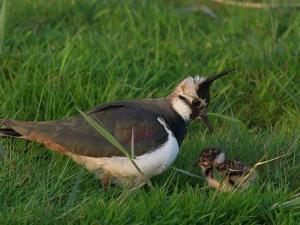Flora & Fauna

Den Helder is rich in flora and fauna. The nature reserves around De Helderse Vallei, referred to collectively as De Helderse Duinen, are home to many birds and mammals like rabbits, hares and foxes, and also members of the marten family, such as the pine marten. Scottish Highlander cows and Koniks horses graze in the Mariëndal and the Grafelijkheidsduinen nature reserves, creating the ideal conditions for a highly varied floristic composition. You can find rare orchids here, such as the fragrant nightshade. The purple reed orchid is a particularly successful species in Mariëndal.
Dunes and beach
The dunes and the beach are a resting place for many migratory birds, but other species also nest here. For example, the wheatear, a species on the protected Red List that is very dependent on our dune areas, breeds in abandoned rabbit burrows. And the wheatear is not the only bird that likes to nest in holes: stock doves, shelducks and sometimes jackdaws do so as well. The sly and clever fox, which has learned to dig up rabbit burrows, is one of these birds’ natural predators. In addition to birds, a fox also eats rabbits. You are likely to encounter this beautiful animal in the early hours of the morning or in the evening at dusk. During the day, you are quite likely to see rabbits. Hares are more likely to be seen in the low polders behind the dunes. Hares can be recognised by their distinctive black-tipped ears.
The mudflats
The mudflats along the coastline of Den Helder play a key role in the life of migratory birds. For many birds coming from the north, the Wadden Sea is the first stopping point on their long flight, which sometimes exceeds 5000 kilometres. The birds arrive here with only one goal in mind: finding food! At low tide, birds such as the knot, dunlin, bar-tailed godwit, oystercatcher and spoonbill search for food. When it is high tide, they are dependent on high-water refuge areas such as the salt marshes of Balgzand, the Razende Bol, and also the Balgzandpolder and Mariëndal. Walkers who move quietly have a good chance of seeing these beautiful birds here. If you are looking for a unique, beautiful photo of these mudflat birds, book the photo hide in the Balgzandpolder. You can also take a walk on the mudflats with volunteers arranged by natuurinformatiecentrum ’t Kuitje, who are members of the Waddenvereniging and Landschap Noord-Holland. During the walk, you will learn more about the food the birds find in the mudflats, such as cockles, lugworms and clams. You can also see the unusual plants on the seabed, such as sea lavender and marsh samphire.
The woodlands
Walking through the Donkere Duinen, you may notice that this forest consists mainly of black pines. These pines look unviable, especially on the seaward side of the forest. The salty sea breeze has an adverse effect on the trees. The dead pines are slowly being replaced by deciduous trees. The first pine marten was seen in this forest in 2013. You are not likely to encounter this animal yourself. They are shy and roam a large territory. In various places in the forest, a large population of herons start building their nests as early as February. The birds can be seen clearly from the paths and their loud calls drown out other sounds. You have the best view of these colonies of beautiful birds in the trees around the entrance from Hengstepad, on the north side of the forest. As soon as winter has passed, you will see a low barrier and partly buried buckets in the verge next to the forest (and further along the dunes). Toads, awoken by the rising temperatures, leave their hibernation places in the dunes and the forest and head for the welcoming waters of Mariëndal. Every morning, volunteers from Werkgroep Vrijwillig Landschapsbeheer Den Helder check the buckets and make sure that the toads, many of which are natterjack toads, can cross the road safely. Every spring, De Helderse Vallei organises an activity for children who want to help the toads make this crossing. Please check our calendar!
De Helderse Vallei
You can also meet all kinds of animals in De Helderse Vallei! You can pet several animals at the petting farm. There are also 'wild' animals in special areas created in the grounds of De Helderse Vallei:
- There is a Wild Flower Garden, which is full of plants that attract butterflies.
- There is a bird garden, where birds and other animals can rest in quiet surroundings. We have hung up a tree swallow nest box in the bird garden and a bee colony lives there in a hollow tree. There are several foraging areas and a small mound has been created specially for hedgehogs. The bird garden can be viewed from the top of a hill in the grounds.
- Insect hotels have been set up next to the Wild Flower Garden and in the bird garden. The insect hotels provide shelter for small animals, such as solitary wasps, where they are protected from the wind and rain.
- Various nest boxes for birds and bats have been hung up in different parts of the grounds. We have an oystercatcher that has built its nest on the moss roof of the Visitor Centre ever since it opened.
- All the latest special sightings are noted on an observation board in the Visitor Centre. If you observe a bird you are unable to identify, you are welcome to look it up in the books in our library.
- We have binoculars available at the front desk and loan them to visitors who want to go out into the reserve to watch birds.
(Photo: Lapwing - Do van Dijck)
< back to overview



